Layer-by-Layer Self-Assembly Coating for Multi-Functionalized Fabrics: A Scientometric Analysis in CiteSpace (2005–2021)
Abstract
1. Introduction
2. Visualization of the Scientometrics Analysis of LbL Self-Assembly Coatings on Fabrics
2.1. Characteristics of Publication Outputs Analysis
2.2. Keyword Co-Occurrence Analysis
2.3. Keywords Cluster Analysis
- Matrix materials: This aspect mainly includes the specific fabric which contains the number of textiles, #6 polyester-cotton blend and #7 polyamide 66 textiles.
- Materials used in the coating: This section mainly contains the compositions of the coating, which include #4 bio-based coating, #8 polytetrafluoroethylene, #11 cellulose and #12 engineered nanoparticles.
- Functionalization of fabrics: This section mainly includes the properties of the modified fabrics. The properties relate to #1 flammability, #2 washability, #10 antibacterial surface, #13 underwater superoleophobicity, #14 thermal degradation properties and #15 electromagnetic shielding effectiveness.
2.4. Country/Territory/Institute Analysis
3. Functionalization of LbL Self-Assembly Coatings on Fabrics
3.1. LbL Self-Assembly Coating to Reduce the Flammability of the Fabric
3.2. LbL Self-Assembly Coating to Endow the Fabric with an Antibacterial Surface
3.3. LbL Self-Assembly Coating on the Fabric to Shield Ultraviolet (UV) Light
3.4. LbL Self-Assembly Coating to Prepare Hydrophobic Fabric
3.5. Electromagnetic Interference Shielding LbL Self-Assembly Coating on the Fabric
3.6. Wash-Durability of the LbL Self-Assembly Coating on the Fabric
4. Conclusions
Author Contributions
Funding
Institutional Review Board Statement
Informed Consent Statement
Data Availability Statement
Conflicts of Interest
References
- Iler, R.K. Multilayers of colloidal particles. J. Colloid Interface Sci. 1966, 21, 569–594. [Google Scholar] [CrossRef]
- Decher, G.; Hong, J.D.; Schmitt, J. Buildup of ultrathin multilayer films by a self-assembly process: III. Consecutively alternating adsorption of anionic and cationic polyelectrolytes on charged surfaces. Ber. Bunsenges. Phys. Chem. 1992, 210–211, 831–835. [Google Scholar] [CrossRef]
- Zhao, C.; Lin, H.; Cui, Z.; Li, X.; Na, H.; Xing, W. Highly conductive, methanol resistant fuel cell membranes fabricated by layer-by-layer self-assembly of inorganic heteropolyacid. J. Power Sources 2009, 194, 168–174. [Google Scholar] [CrossRef]
- Kim, H.; Eom, T.S.; Cho, W.; Woo, K.; Shon, Y.; Wie, J.J.; Shim, B.S. Soft electronics on asymmetrical porous conducting membranes by molecular layer-by-layer assembly. Sens. Actuators B Chem. 2018, 254, 916–925. [Google Scholar] [CrossRef]
- Yusoff, I.I.; Rohani, R.; Ng, L.Y.; Mohammad, A.W. Conductive polyelectrolyte multilayers PANI membranes synthesis for tunable filtration ranges. J. Mater. Sci. 2019, 54, 12988–13005. [Google Scholar] [CrossRef]
- Perera, V.S.; Liu, H.; Wang, Z.-Q.; Huang, S.D. Cell-Permeable Au@ZnMoS4 Core–Shell Nanoparticles: Toward a Novel Cellular Copper Detoxifying Drug for Wilson’s Disease. Chem. Mater. 2013, 25, 4703–4709. [Google Scholar] [CrossRef]
- Jomekian, A.; Behbahani, R.M.; Mohammadi, T.; Kargari, A. Innovative layer by layer and continuous growth methods for synthesis of ZIF-8 membrane on porous polymeric support using poly(ether-block-amide) as structure directing agent for gas separation. Microporous Mesoporous Mater. 2016, 234, 43–54. [Google Scholar] [CrossRef]
- Cerkez, I.; Kocer, H.B.; Worley, S.D.; Broughton, R.M.; Huang, T.S. N-Halamine Biocidal Coatings via a Layer-by-Layer Assembly Technique. Langmuir 2011, 27, 4091–4097. [Google Scholar] [CrossRef] [PubMed]
- Rahman, M.Z.; Kundu, C.K.; Wang, X.; Song, L.; Hu, Y. Bio-inspired and dual interaction-based layer-by-layer assembled coatings for superior flame retardancy and hydrophilicity of polyamide 6.6 textiles. Eur. Polym. J. 2021, 147, 110320. [Google Scholar] [CrossRef]
- Xue, C.-H.; Du, M.-M.; Guo, X.-J.; Liu, B.-Y.; Wei, R.-X.; Li, H.-G.; Huang, M.-C.; Deng, F.-Q.; Jia, S.-T. Fabrication of superhydrophobic photothermal conversion fabric via layer-by-layer assembly of carbon nanotubes. Cellulose 2021, 28, 5107–5121. [Google Scholar] [CrossRef]
- Schütte, M.; Kurth, D.G.; Linford, M.R.; Cölfen, H.; Möhwald, H. Metallosupramolecular Thin Polyelectrolyte Films. Angew. Chem. Int. Ed. 1998, 37, 2891–2893. [Google Scholar] [CrossRef]
- Stockton, W.B.; Rubner, M.F. Molecular-Level Processing of Conjugated Polymers. 4. Layer-by-Layer Manipulation of Polyaniline via Hydrogen-Bonding Interactions. Macromolecules 1997, 30, 2717–2725. [Google Scholar] [CrossRef]
- Anzai, J.I.; Kobayashi, Y.; Nakamura, N.; Nishimura, M.; Hoshi, T. Layer-by-Layer Construction of Multilayer Thin Films Composed of Avidin and Biotin-Labeled Poly(amine)s. Langmuir 1999, 15, 221–226. [Google Scholar] [CrossRef]
- Deshmukh, P.K.; Ramani, K.P.; Singh, S.S.; Tekade, A.R.; Bari, S.B. Stimuli-sensitive layer-by-layer (LbL) self-assembly systems: Targeting and biosensory applications. J. Control. Release 2013, 166, 294–306. [Google Scholar] [CrossRef] [PubMed]
- Laufer, G.; Kirkland, C.; Morgan, A.B.; Grunlan, J.C. Exceptionally Flame Retardant Sulfur-Based Multilayer Nanocoating for Polyurethane Prepared from Aqueous Polyelectrolyte Solutions. ACS Macro Lett. 2013, 2, 361–365. [Google Scholar] [CrossRef]
- Xiong, M.; Ren, Z.; Liu, W. Fabrication of UV-resistant and superhydrophobic surface on cotton fabric by functionalized polyethyleneimine/SiO2 via layer-by-layer assembly and dip-coating. Cellulose 2019, 26, 8951–8962. [Google Scholar] [CrossRef]
- Carosio, F.; Laufer, G.; Alongi, J.; Camino, G.; Grunlan, J.C. Layer-by-layer assembly of silica-based flame retardant thin film on PET fabric. Polym. Degrad. Stab. 2011, 96, 745–750. [Google Scholar] [CrossRef]
- Fan, W.; Zhang, C.; Tjiu, W.W.; Liu, T.X. Fabrication of electrically conductive graphene/polystyrene composites via a combination of latex and layer-by-layer assembly approaches. J. Mater. Res. 2013, 28, 611–619. [Google Scholar] [CrossRef]
- Duong, P.H.H.; Zuo, J.; Chung, T.S. Highly crosslinked layer-by-layer polyelectrolyte FO membranes: Understanding effects of salt concentration and deposition time on FO performance. J. Membr. Sci. 2013, 427, 411–421. [Google Scholar] [CrossRef]
- Zhang, M.; Wang, S.L.; Wang, C.Y.; Li, J. A facile method to fabricate superhydrophobic cotton fabrics. Appl. Surf. Sci. 2012, 261, 561–566. [Google Scholar] [CrossRef]
- Li, Y.-C.; Mannen, S.; Schulz, J.; Grunlan, J.C. Growth and fire protection behavior of POSS-based multilayer thin films. J. Mater. Chem. 2011, 21, 3060–3069. [Google Scholar] [CrossRef]
- Tsou, C.H.; Suen, M.C.; Tsou, C.Y.; Chen, J.C.; Yeh, J.T.; Lin, S.M.; Lai, Y.C.; Hwang, J.Z.; Huang, S.H.; Hung, W.S.; et al. Argon Plasma in a New Process for Improving the Physical and Anti-bacterial Properties of Crosslinked Cotton Cellulose with Dimethyloldihydroxyethyleneurea-Maleic Acid. Fibres Text. East. Eur. 2015, 23, 49–56. [Google Scholar]
- Alongi, J.; Ciobanu, M.; Malucelli, G. Thermal stability, flame retardancy and mechanical properties of cotton fabrics treated with inorganic coatings synthesized through sol-gel processes. Carbohydr. Polym. 2012, 87, 2093–2099. [Google Scholar] [CrossRef]
- Jiang, Z.; Wang, X.; Zhang, Y.; Ma, H.T.; Lv, L.H.; Cui, Y.Z.; Pang, G.B. Surface Modification of Linen Fabric via UV Induced Grafting to Improve Dyeability and Wearability. J. Nat. Fibers 2018, 15, 474–482. [Google Scholar] [CrossRef]
- Wang, Y.; Lorandi, F.; Fantin, M.; Chmielarz, P.; Isse, A.A.; Gennaro, A.; Matyjaszewski, K. Miniemulsion ARGET ATRP via Interfacial and Ion-Pair Catalysis: From ppm to ppb of Residual Copper. Macromolecules 2017, 50, 8417–8425. [Google Scholar] [CrossRef]
- Zaborniak, I.; Surmacz, K.; Chmielarz, P. Synthesis of sugar-based macromolecules via sono-ATRP in miniemulsion. Polym. Adv. Technol. 2020, 31, 1972–1979. [Google Scholar] [CrossRef]
- Zaborniak, I.; Surmacz, K.; Flejszar, M.; Chmielarz, P. Triple-functional riboflavin-based molecule for efficient atom transfer radical polymerization in miniemulsion media. J. Appl. Polym. Sci. 2020, 137, 49275. [Google Scholar] [CrossRef]
- Zaborniak, I.; Chmielarz, P. Temporally Controlled Ultrasonication-Mediated Atom Transfer Radical Polymerization in Miniemulsion. Macromol. Chem. Phys. 2019, 220, 1900285. [Google Scholar] [CrossRef]
- Surmacz, K.; Chmielarz, P. Low Ppm Atom Transfer Radical Polymerization in (Mini)Emulsion Systems. Materials 2020, 13, 1717. [Google Scholar] [CrossRef]
- Jiang, C.; Wang, Q.H.; Wang, T.M. Thermoresponsive PNIPAAm-modified cotton fabric surfaces that switch between superhydrophilicity and superhydrophobicity. Appl. Surf. Sci. 2012, 258, 4888–4892. [Google Scholar] [CrossRef]
- Zhao, J.; Fei, J.; Gao, L.; Cui, W.; Yang, Y.; Wang, A.; Li, J. Bioluminescent Microcapsules: Applications in Activating a Photosensitizer. Chem. Eur. J. 2013, 19, 4548–4555. [Google Scholar] [CrossRef]
- Liu, Q.; Gao, S.; Zhao, Y.; Tao, W.; Yu, X.; Zhi, M. Review of layer-by-layer self-assembly technology for fire protection of flexible polyurethane foam. J. Mater. Sci. 2021, 56, 9605–9643. [Google Scholar] [CrossRef]
- Jiang, Y.; Ritchie, B.W.; Benckendorff, P. Bibliometric visualisation: An application in tourism crisis and disaster management research. Curr. Issues Tour. 2019, 22, 1925–1957. [Google Scholar] [CrossRef]
- Xiao, F.; Li, C.; Sun, J.; Zhang, L. Knowledge Domain and Emerging Trends in Organic Photovoltaic Technology: A Scientometric Review Based on CiteSpace Analysis. Front. Chem. 2017, 5, 67. [Google Scholar] [CrossRef]
- Chen, C.M. Searching for intellectual turning points: Progressive knowledge domain visualization. Proc. Natl. Acad. Sci. USA 2004, 101, 5303–5310. [Google Scholar] [CrossRef]
- Azam, A.; Ahmed, A.; Wang, H.; Wang, Y.; Zhang, Z. Knowledge structure and research progress in wind power generation (WPG) from 2005 to 2020 using CiteSpace based scientometric analysis. J. Clean. Prod. 2021, 295, 126496. [Google Scholar] [CrossRef]
- He, Q.; Wang, G.; Luo, L.; Shi, Q.; Xie, J.; Meng, X. Mapping the managerial areas of Building Information Modeling (BIM) using scientometric analysis. Int. J. Proj. Manag. 2017, 35, 670–685. [Google Scholar] [CrossRef]
- Shi, Y.; Liu, X. Research on the Literature of Green Building Based on the Web of Science: A Scientometric Analysis in CiteSpace (2002–2018). Sustainability 2019, 11, 3716. [Google Scholar] [CrossRef]
- Malucelli, G.; Carosio, F.; Alongi, J.; Fina, A.; Frache, A.; Camino, G. Materials engineering for surface-confined flame retardancy. Mater. Sci. Eng. R 2014, 84, 1–20. [Google Scholar] [CrossRef]
- Qiu, X.; Li, Z.; Li, X.; Zhang, Z. Flame retardant coatings prepared using layer by layer assembly: A review. Chem. Eng. J. 2018, 334, 108–122. [Google Scholar] [CrossRef]
- Ma, C.; Qiu, S.L.; Xiao, Y.L.; Zhang, K.; Zheng, Y.P.; Xing, W.Y.; Hu, Y. Fabrication of fire safe rigid polyurethane foam with reduced release of CO and NOx and excellent physical properties by combining phosphine oxide-containing hyperbranched polyol and expandable graphite. Chem. Eng. J. 2022, 431, 133347. [Google Scholar] [CrossRef]
- Laufer, G.; Carosio, F.; Martinez, R.; Camino, G.; Grunlan, J.C. Growth and fire resistance of colloidal silica-polyelectrolyte thin film assemblies. J. Colloid Interface Sci. 2011, 356, 69–77. [Google Scholar] [CrossRef]
- Huang, G.; Liang, H.; Wang, X.; Gao, J. Poly(acrylic acid)/Clay Thin Films Assembled by Layer-by-Layer Deposition for Improving the Flame Retardancy Properties of Cotton. Ind. Eng. Chem. Res. 2012, 51, 12299–12309. [Google Scholar] [CrossRef]
- Chang, S.; Slopek, R.P.; Condon, B.; Grunlan, J.C. Surface Coating for Flame-Retardant Behavior of Cotton Fabric Using a Continuous Layer-by-Layer Process. Ind. Eng. Chem. Res. 2014, 53, 3805–3812. [Google Scholar] [CrossRef]
- Fang, Y.; Liu, X.; Fei, W. Nacre-mimetic CH/MMT fabrication coating on PET fabric for improving anti-dripping performance. Int. J. Cloth. Sci. Technol. 2020, 32, 803–812. [Google Scholar] [CrossRef]
- Rehman, Z.U.; Huh, S.-H.; Ullah, Z.; Pan, Y.-T.; Churchill, D.G.; Koo, B.H. LBL generated fire retardant nanocomposites on cotton fabric using cationized starch-clay-nanoparticles matrix. Carbohydr. Polym. 2021, 274, 118626. [Google Scholar] [CrossRef] [PubMed]
- Mateos, A.J.; Cain, A.A.; Grunlan, J.C. Large-Scale Continuous Immersion System for Layer-by-Layer Deposition of Flame Retardant and Conductive Nanocoatings on Fabric. Ind. Eng. Chem. Res. 2014, 53, 6409–6416. [Google Scholar] [CrossRef]
- Chen, X.; Fang, F.; Zhang, X.; Ding, X.; Wang, Y.; Chen, L.; Tian, X. Flame-retardant, electrically conductive and antimicrobial multifunctional coating on cotton fabric via layer-by-layer assembly technique. RSC Adv. 2016, 6, 27669–27676. [Google Scholar]
- Xue, C.-H.; Wu, Y.; Guo, X.-J.; Liu, B.-Y.; Wang, H.-D.; Jia, S.-T. Superhydrophobic, flame-retardant and conductive cotton fabrics via layer-by-layer assembly of carbon nanotubes for flexible sensing electronics. Cellulose 2020, 27, 3455–3468. [Google Scholar] [CrossRef]
- Alongi, J.; Carosio, F.; Malucelli, G. Layer by layer complex architectures based on ammonium polyphosphate, chitosan and silica on polyester-cotton blends: Flammability and combustion behaviour. Cellulose 2012, 19, 1041–1050. [Google Scholar] [CrossRef]
- Alongi, J.; Carosio, F.; Frache, A.; Malucelli, G. Layer by Layer coatings assembled through dipping, vertical or horizontal spray for cotton flame retardancy. Carbohydr. Polym. 2013, 92, 114–119. [Google Scholar] [CrossRef]
- Carosio, F.; Di Blasio, A.; Cuttica, F.; Alongi, J.; Frache, A.; Malucelli, G. Flame Retardancy of Polyester Fabrics Treated by Spray-Assisted Layer-by-Layer Silica Architectures. Ind. Eng. Chem. Res. 2013, 52, 9544–9550. [Google Scholar] [CrossRef]
- Lin, D.; Zeng, X.; Li, H.; Lai, X. Facile fabrication of superhydrophobic and flame-retardant coatings on cotton fabrics via layer-by-layer assembly. Cellulose 2018, 25, 3135–3149. [Google Scholar] [CrossRef]
- Apaydin, K.; Laachachi, A.; Ball, V.; Jimenezd, M.; Bourbigot, S.; Ruch, D. Layer-by-layer deposition of a TiO2-filled intumescent coating and its effect on the flame retardancy of polyamide and polyester fabrics. Colloids Surf. A 2015, 469, 1–10. [Google Scholar] [CrossRef]
- Lan, Y.; Wang, Y.; Zhang, H.; Shan, P.; Shi, X.; Long, M. A facile approach to achieve multifunctional polyethylene terephthalate fabrics with durable superhydrophobicity, photocatalysis and self-quenched flame retardance. New J. Chem. 2020, 44, 14198–14210. [Google Scholar] [CrossRef]
- Peng, S.; Wang, Y.; Lan, Y.; Shi, X.; Zhang, H.; Qu, H.; Xu, J. Rational design of multifunctional superoleophobic/superhydrophilic, photocatalytic, and fire-retardant polyethylene terephthalate fabrics through layer-by-layer technique. Compos. Part B 2020, 200, 108264. [Google Scholar] [CrossRef]
- Carosio, F.; Alongi, J.; Malucelli, G. Flammability and combustion properties of ammonium polyphosphate-/poly(acrylic acid)-based layer by layer architectures deposited on cotton, polyester and their blends. Polym. Degrad. Stab. 2013, 98, 1626–1637. [Google Scholar] [CrossRef]
- Wang, Y.-Y.; Fang, F.; Ding, X.; Chen, X.-X.; Zheng, K.; Chen, L.; Tian, X.-Y.; Zhang, X. Improvement of Flame Retardant Property of Cotton Fabric by Construction of Carbon Nanotube-based Hybrid Coating via Self-assembly. Acta Polym. Sin. 2016, 1695–1703. [Google Scholar]
- Yang, J.-C.; Liao, W.; Deng, S.-B.; Cao, Z.-J.; Wang, Y.-Z. Flame retardation of cellulose-rich fabrics via a simplified layer-by-layer assembly. Carbohydr. Polym. 2016, 151, 434–440. [Google Scholar] [CrossRef] [PubMed]
- Fang, Y.; Liu, X.; Tao, X. Intumescent flame retardant and anti-dripping of PET fabrics through layer-by-layer assembly of chitosan and ammonium polyphosphate. Prog. Org. Coat. 2019, 134, 162–168. [Google Scholar] [CrossRef]
- Luo, L.; Yu, H.; Zhai, L.; Lu, J.; Zhang, S.; Gan, L.; Ahmad, I.; Zhou, N.; Liu, C.; Huang, J. Surface Regulation of Iron Phosphonate to Achieve Nanoscale Dispersion in Aqueous Flame-retardant System and Promote Carbonization of Cotton Fabric. Fibers Polym. 2021, 22, 2635–2646. [Google Scholar] [CrossRef]
- Fang, Y.; Sun, W.; Liu, H.; Liu, X. Construction of eco-friendly flame retardant and dripping-resistant coating on polyester fabrics. Surf. Eng. 2021, 37, 1067–1073. [Google Scholar] [CrossRef]
- Laufer, G.; Kirkland, C.; Morgan, A.B.; Grunlan, J.C. Intumescent Multilayer Nanocoating, Made with Renewable Polyelectrolytes, for Flame-Retardant Cotton. Biomacromolecules 2012, 13, 2843–2848. [Google Scholar] [CrossRef]
- Wang, X.; Quintero Romero, M.; Zhang, X.-Q.; Wang, R.; Wang, D.-Y. Intumescent multilayer hybrid coating for flame retardant cotton fabrics based on layer-by-layer assembly and sol-gel process. RSC Adv. 2015, 5, 10647–10655. [Google Scholar] [CrossRef]
- Kundu, C.K.; Wang, W.; Zhou, S.; Wang, X.; Sheng, H.; Pan, Y.; Song, L.; Hu, Y. A green approach to constructing multilayered nanocoating for flame retardant treatment of polyamide 66 fabric from chitosan and sodium alginate. Carbohydr. Polym. 2017, 166, 131–138. [Google Scholar]
- Cheng, X.-W.; Guan, J.-P.; Yang, X.-H.; Tang, R.-C.; Yao, F. A bio-resourced phytic acid/chitosan polyelectrolyte complex for the flame retardant treatment of wool fabric. J. Clean. Prod. 2019, 223, 342–349. [Google Scholar] [CrossRef]
- Magovac, E.; Jordanov, I.; Grunlan, J.C.; Bischof, S. Environmentally-Benign Phytic Acid-Based Multilayer Coating for Flame Retardant Cotton. Materials 2020, 13, 5492. [Google Scholar] [CrossRef] [PubMed]
- Kundu, C.K.; Song, L.; Hu, Y. Sucrose derivative as a cross-linking agent in enhancing coating stability and flame retardancy of polyamide 66 textiles. Prog. Org. Coat. 2021, 159, 189–196. [Google Scholar] [CrossRef]
- Carosio, F.; Cuttica, F.; Di Blasio, A.; Alongi, J.; Malucelli, G. Layer by layer assembly of flame retardant thin films on closed cell PET foams: Efficiency of ammonium polyphosphate versus DNA. Polym. Degrad. Stab. 2015, 113, 189–196. [Google Scholar] [CrossRef]
- Pan, H.; Song, L.; Ma, L.; Pan, Y.; Liew, K.M.; Hu, Y. Layer-by-layer assembled thin films based on fully biobased polysaccharides: Chitosan and phosphorylated cellulose for flame-retardant cotton fabric. Cellulose 2014, 21, 2995–3006. [Google Scholar] [CrossRef]
- Li, Y.-C.; Schulz, J.; Grunlan, J.C. Polyelectrolyte/Nanosilicate Thin-Film Assemblies: Influence of pH on Growth, Mechanical Behavior, and Flammability. ACS Appl. Mater. Interfaces 2009, 1, 2338–2347. [Google Scholar] [CrossRef]
- Carosio, F.; Alongi, J.; Malucelli, G. α-Zirconium phosphate-based nanoarchitectures on polyester fabrics through layer-by-layer assembly. J. Mater. Chem. 2011, 21, 10370–10376. [Google Scholar]
- Li, Y.-C.; Mannen, S.; Morgan, A.B.; Chang, S.; Yang, Y.-H.; Condon, B.; Grunlan, J.C. Intumescent All-Polymer Multilayer Nanocoating Capable of Extinguishing Flame on Fabric. Adv. Mater. 2011, 23, 3926–3931. [Google Scholar] [CrossRef]
- Zhang, T.; Yan, H.; Wang, L.; Fang, Z. Controlled Formation of Self-Extinguishing Intumescent Coating on Ramie Fabric via Layer-by-Layer Assembly. Ind. Eng. Chem. Res. 2013, 52, 6138–6146. [Google Scholar] [CrossRef]
- Apaydin, K.; Laachachi, A.; Ball, V.; Jimenez, M.; Bourbigot, S.; Toniazzo, V.; Ruch, D. Intumescent coating of (polyallylamine-polyphosphates) deposited on polyamide fabrics via layer-by-layer technique. Polym. Degrad. Stab. 2014, 106, 158–164. [Google Scholar]
- Liu, L.; Pan, Y.; Wang, Z.; Hou, Y.; Gui, Z.; Hu, Y. Layer-by-Layer Assembly of Hypophosphorous Acid-Modified Chitosan Based Coating for Flame-Retardant Polyester-Cotton Blends. Ind. Eng. Chem. Res. 2017, 56, 9429–9436. [Google Scholar] [CrossRef]
- Pan, Y.; Liu, L.; Song, L.; Hu, Y.; Wang, W.; Zhao, H. Durable flame retardant treatment of polyethylene terephthalate (PET) fabric with cross-linked layer-by-layer assembled coating. Polym. Degrad. Stab. 2019, 165, 145–152. [Google Scholar] [CrossRef]
- Wang, B.; Lai, X.; Li, H.; Jiang, C.; Gao, J.; Zeng, X. Multifunctional MXene/Chitosan-Coated Cotton Fabric for Intelligent Fire Protection. ACS Appl. Mater. Interfaces 2021, 13, 23020–23029. [Google Scholar] [CrossRef]
- Zhang, T.; Yan, H.; Peng, M.; Wang, L.; Ding, H.; Fang, Z. Construction of flame retardant nanocoating on ramie fabric via layer-by-layer assembly of carbon nanotube and ammonium polyphosphate. Nanoscale 2013, 5, 3013–3021. [Google Scholar]
- Gomes, A.P.; Mano, J.F.; Queiroz, J.A.; Gouveia, I.C. Layer-by-layer deposition of antimicrobial polymers on cellulosic fibers: A new strategy to develop bioactive textiles. Polym. Adv. Technol. 2013, 24, 1005–1010. [Google Scholar] [CrossRef]
- Demir, A.; Turemen, M. Structural characterization of LbL assembled multilayers by using different polyelectrolytes on cotton fabrics. Fibers Polym. 2017, 18, 2298–2306. [Google Scholar]
- Li, S.; Lin, X.; Liu, Y.; Li, R.; Ren, X.; Huang, T.-S. Phosphorus-nitrogen-silicon-based assembly multilayer coating for the preparation of flame retardant and antimicrobial cotton fabric. Cellulose 2019, 26, 4213–4223. [Google Scholar] [CrossRef]
- Gadkari, R.R.; Ali, S.W.; Joshi, M.; Rajendran, S.; Das, A.; Alagirusamy, R. Leveraging antibacterial efficacy of silver loaded chitosan nanoparticles on layer-by-layer self-assembled coated cotton fabric. Int. J. Biol. Macromol. 2020, 162, 548–560. [Google Scholar] [PubMed]
- Saini, S.; Gupta, A.; Singh, N.; Sheikh, J. Functionalization of linen fabric using layer by layer treatment with chitosan and green tea extract. J. Ind. Eng. Chem. 2020, 82, 138–143. [Google Scholar] [CrossRef]
- Gadkari, R.R.; Gupta, A.; Teke, U.; Awadhiya, A.; Shahadat, M.; Ali, W.; Das, A.; Alagirusamy, R. A sustainable way for surface functionalisation of PET nonwoven with novel chitosan-cinnamaldehyde cross-linked nanoparticles. J. Ind. Eng. Chem. 2021, 99, 214–223. [Google Scholar]
- Alebeid, O.K.; Zhao, T. Review on: Developing UV protection for cotton fabric. J. Text. Inst. 2017, 108, 2027–2039. [Google Scholar] [CrossRef]
- Li, Z.-R.; Xu, H.-Y.; Fu, K.-J.; Wang, L.-J. ZnO nanosol for enhancing the UV-protective property of cotton fabric and pigment dyeing in a single bath. AATCC Rev. 2007, 7, 38–41. [Google Scholar]
- El Shafei, A.; Abou-Okeil, A. ZnO/carboxymethyl chitosan bionano-composite to impart antibacterial and UV protection for cotton fabric. Carbohydr. Polym. 2011, 83, 920–925. [Google Scholar]
- Wang, C.; Lv, J.; Ren, Y.; Zhou, Q.; Chen, J.; Zhi, T.; Lu, Z.; Gao, D.; Ma, Z.; Jin, L. Cotton fabric with plasma pretreatment and ZnO/Carboxymethyl chitosan composite finishing for durable UV resistance and antibacterial property. Carbohydr. Polym. 2016, 138, 106–113. [Google Scholar]
- Jin, J.; Feng, K.; Liu, X. Enhanced photocatalytic degradation and UV protection properties of BiOCl nanosheets coating for cotton fabric. Funct. Mater. Lett. 2018, 11, 1850052. [Google Scholar]
- Xu, Q.; Wang, P.; Zhang, Y.; Li, C. Durable Antibacterial and UV Protective Properties of Cotton Fabric Coated with Carboxymethyl Chitosan and Ag/TiO2 Composite Nanoparticles. Fibers Polym. 2021, 23, 386–395. [Google Scholar] [CrossRef]
- Wang, Q.; Hauser, P.J. Developing a novel UV protection process for cotton based on layer-by-layer self-assembly. Carbohydr. Polym. 2010, 81, 491–496. [Google Scholar] [CrossRef]
- Ugur, S.S.; Sariisik, M.; Aktas, A.H.; Ucar, M.C.; Erden, E. Modifying of Cotton Fabric Surface with Nano-ZnO Multilayer Films by Layer-by-Layer Deposition Method. Nanoscale Res. Lett. 2010, 5, 1204–1210. [Google Scholar] [CrossRef] [PubMed]
- Zhao, Y.; Xu, Z.; Wang, X.; Lin, T. Superhydrophobic and UV-blocking cotton fabrics prepared by layer-by-layer assembly of organic UV absorber intercalated layered double hydroxides. Appl. Surf. Sci. 2013, 286, 364–370. [Google Scholar] [CrossRef]
- Safi, K.; Kant, K.; Bramhecha, I.; Mathur, P.; Sheikh, J. Multifunctional modification of cotton using layer-by-layer finishing with chitosan, sodium lignin sulphonate and boric acid. Int. J. Biol. Macromol. 2020, 158, 903–910. [Google Scholar] [CrossRef]
- Tian, M.; Hu, X.; Qu, L.; Du, M.; Zhu, S.; Sun, Y.; Han, G. Ultraviolet protection cotton fabric achieved via layer-by-layer self-assembly of graphene oxide and chitosan. Appl. Surf. Sci. 2016, 377, 141–148. [Google Scholar] [CrossRef]
- Zhao, Y.; Tang, Y.; Wang, X.; Lin, T. Superhydrophobic cotton fabric fabricated by electrostatic assembly of silica nanoparticles and its remarkable buoyancy. Appl. Surf. Sci. 2010, 256, 6736–6742. [Google Scholar] [CrossRef]
- Joung, Y.S.; Buie, C.R. Antiwetting Fabric Produced by a Combination of Layer-by-Layer Assembly and Electrophoretic Deposition of Hydrophobic Nanoparticles. ACS Appl. Mater. Interfaces 2015, 7, 20100–20110. [Google Scholar]
- Li, H.; Yang, J.; Li, P.; Lan, T.; Peng, L. A facile method for preparation superhydrophobic paper with enhanced physical strength and moisture-proofing property. Carbohydr. Polym. 2017, 160, 9–17. [Google Scholar] [CrossRef]
- Pan, Y.; Liang, Q.; Song, L.; Zhao, H. Fabrication of layer-by-layer self-assembled coating modified cotton fabric with flame retardancy and hydrophobicity based on sepiolite. Polym. Plast. Technol. Mater. 2021, 60, 1368–1376. [Google Scholar]
- Liu, L.-X.; Chen, W.; Zhang, H.-B.; Wang, Q.-W.; Guan, F.; Yu, Z.-Z. Flexible and Multifunctional Silk Textiles with Biomimetic Leaf-Like MXene/Silver Nanowire Nanostructures for Electromagnetic Interference Shielding, Humidity Monitoring, and Self-Derived Hydrophobicity. Adv. Funct. Mater. 2019, 29, 1905197. [Google Scholar] [CrossRef]
- Zhao, Y.; Xu, Z.; Wang, X.; Lin, T. Photoreactive Azido-Containing Silica Nanoparticle/Polycation Multilayers: Durable Superhydrophobic Coating on Cotton Fabrics. Langmuir 2012, 28, 6328–6335. [Google Scholar] [CrossRef] [PubMed]
- Guo, X.-J.; Xue, C.-H.; Li, M.; Li, X.; Ma, J.-Z. Fabrication of robust, superhydrophobic, electrically conductive and UV-blocking fabrics via layer-by-layer assembly of carbon nanotubes. RSC Adv. 2017, 7, 25560–25565. [Google Scholar] [CrossRef]
- Singh, A.; Mishra, M.; Sambyal, P.; Gupta, B.; Singh, B.; Chandra, A.; Dhawan, S.K. Encapsulation of γ-Fe2O3 decorated reduced graphene oxide in polyaniline core–shell tubes as an exceptional tracker for electromagnetic environmental pollution. J. Mater. Chem. A 2014, 2, 3581–3593. [Google Scholar] [CrossRef]
- Wang, Y.; Wang, W.; Yu, D. Three-phase heterostructures f-NiFe2O4/PANI/PI EMI shielding fabric with high Microwave Absorption Performance. Appl. Surf. Sci. 2017, 425, 518–525. [Google Scholar] [CrossRef]
- Yin, G.; Wang, Y.; Wang, W.; Qu, Z.; Yu, D. A Flexible Electromagnetic Interference Shielding Fabric Prepared by Construction of PANI/MXene Conductive Network via Layer-by-Layer Assembly. Adv. Mater. Interfaces 2021, 8, 2001893. [Google Scholar] [CrossRef]
- Mao, Y.; Wang, D.; Fu, S. Layer-by-layer self-assembled nanocoatings of Mxene and P, N-co-doped cellulose nanocrystals onto cotton fabrics for significantly reducing fire hazards and shielding electromagnetic interference. Compos. Part A 2022, 153, 106751. [Google Scholar] [CrossRef]
- Lan, C.; Li, C.; Hu, J.; Yang, S.; Qiu, Y.; Ma, Y. High-Loading Carbon Nanotube/Polymer Nanocomposite Fabric Coatings Obtained by Capillarity-Assisted “Excess Assembly” for Electromagnetic Interference Shielding. Adv. Mater. Interfaces 2018, 5, 1800116. [Google Scholar] [CrossRef]
- Tian, M.; Du, M.; Qu, L.; Chen, S.; Zhu, S.; Han, G. Electromagnetic interference shielding cotton fabrics with high electrical conductivity and electrical heating behavior via layer-by-layer self-assembly route. RSC Adv. 2017, 7, 42641–42652. [Google Scholar] [CrossRef]
- Zhang, Y.; Tian, W.; Liu, L.; Cheng, W.; Wang, W.; Liew, K.M.; Wang, B.; Hu, Y. Eco-friendly flame retardant and electromagnetic interference shielding cotton fabrics with multi-layered coatings. Chem. Eng. J. 2019, 372, 1077–1090. [Google Scholar] [CrossRef]
- Duan, M.; Hou, Y.; Guo, M.; Li, X.; Li, X.; Wang, J.; Ma, Y. Tailoring Electromagnetic Interference Shielding Performance of Conductive Nanocomposite Coating Using Textile Substrates. Adv. Mater. Interfaces 2021, 8, 2101089. [Google Scholar] [CrossRef]
- Lan, C.; Zou, L.; Wang, N.; Qiu, Y.; Ma, Y. Multi-reflection-enhanced electromagnetic interference shielding performance of conductive nanocomposite coatings on fabrics. J. Colloid Interface Sci. 2021, 590, 467–475. [Google Scholar] [CrossRef] [PubMed]
- Chen, S.; Li, X.; Li, Y.; Sun, J. Intumescent flame-retardant and self-healing superhydrophobic coatings on cotton fabric. ACS Nano 2015, 9, 4070–4076. [Google Scholar] [CrossRef] [PubMed]
- Carosio, F.; Alongi, J. Few durable layers suppress cotton combustion due to the joint combination of layer by layer assembly and UV-curing. RSC Adv. 2015, 5, 71482–71490. [Google Scholar] [CrossRef]
- Pan, Y.; Wang, W.; Liu, L.; Ge, H.; Song, L.; Hu, Y. Influences of metal ions crosslinked alginate based coatings on thermal stability and fire resistance of cotton fabrics. Carbohydr. Polym. 2017, 170, 133–139. [Google Scholar] [CrossRef]
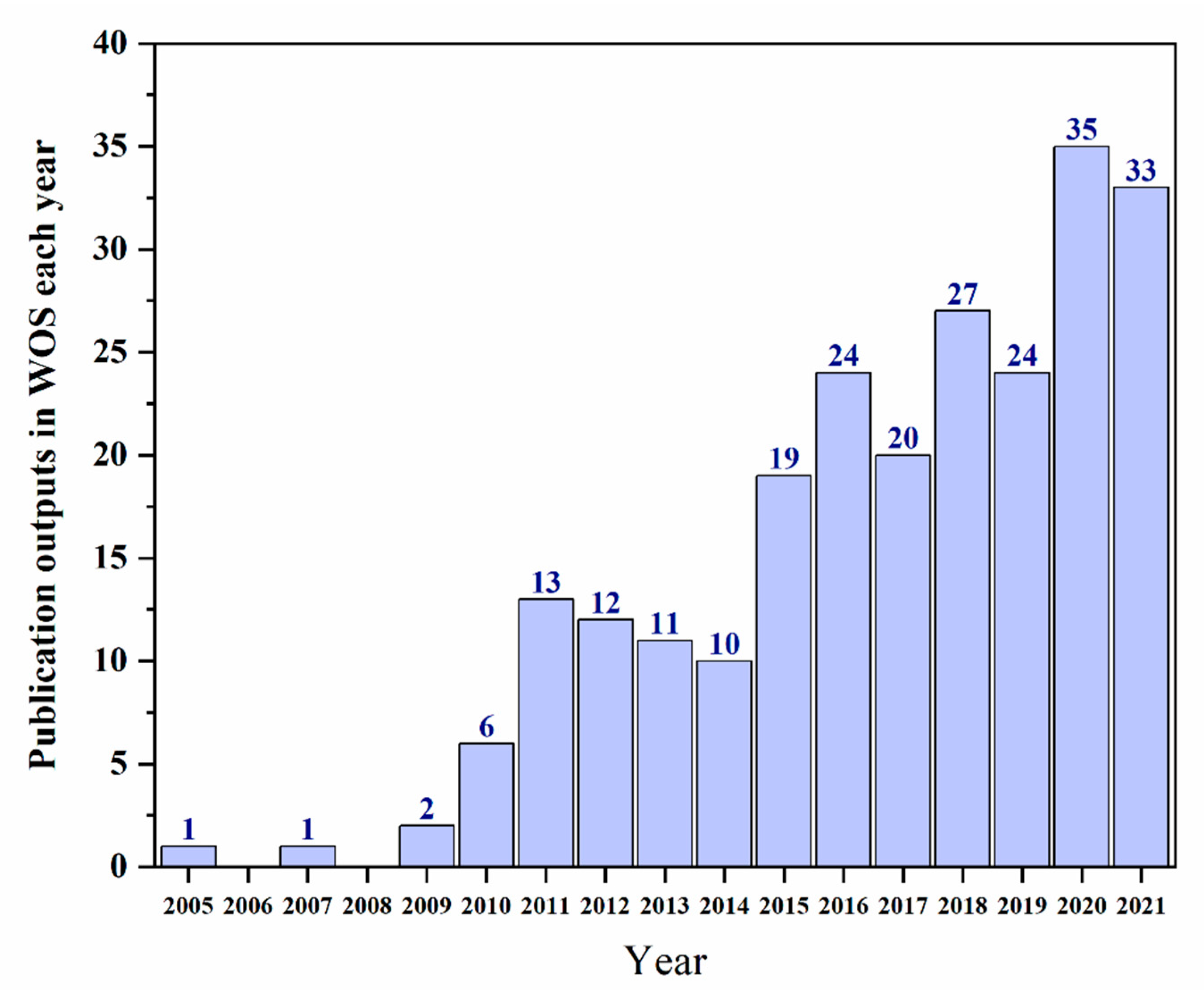
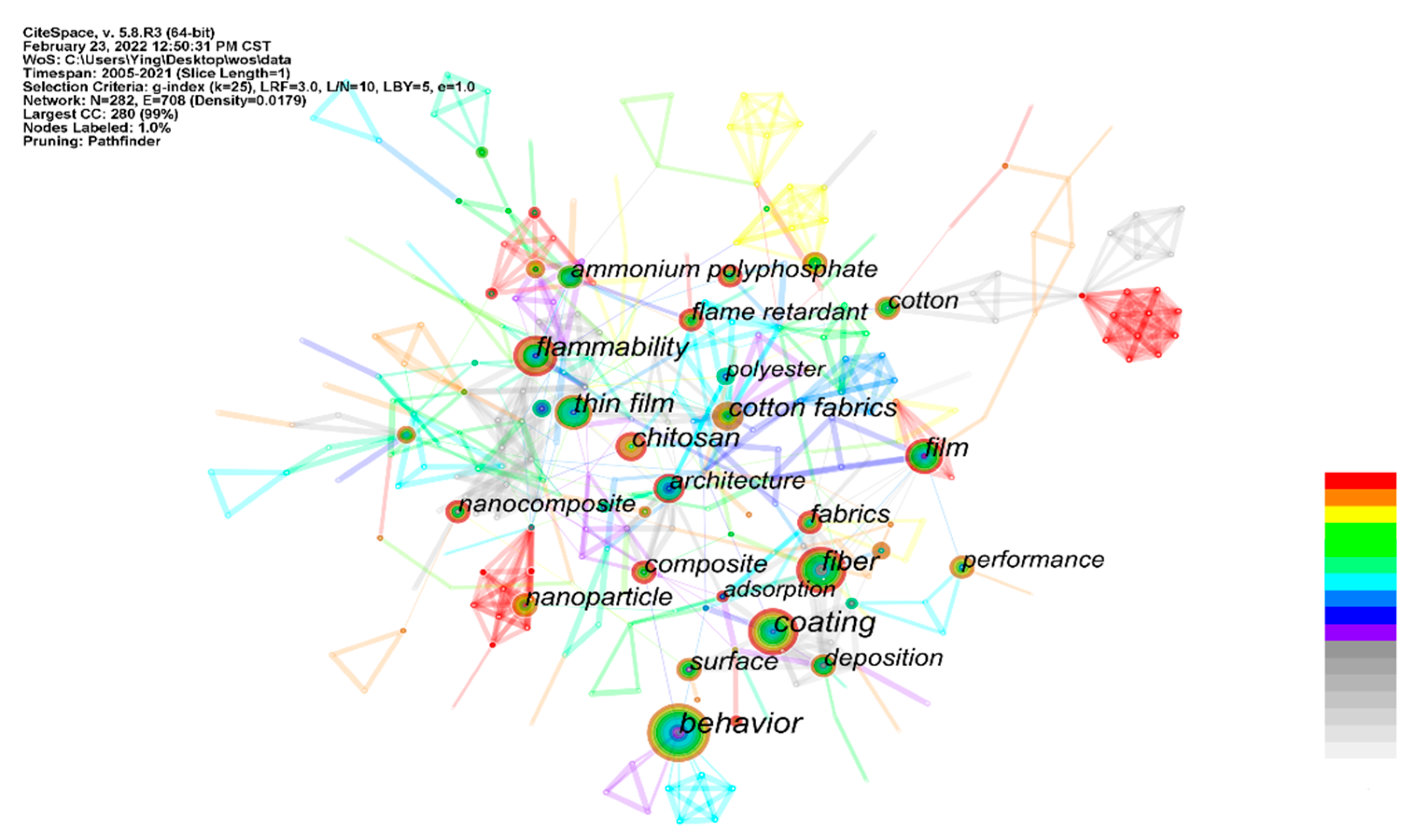
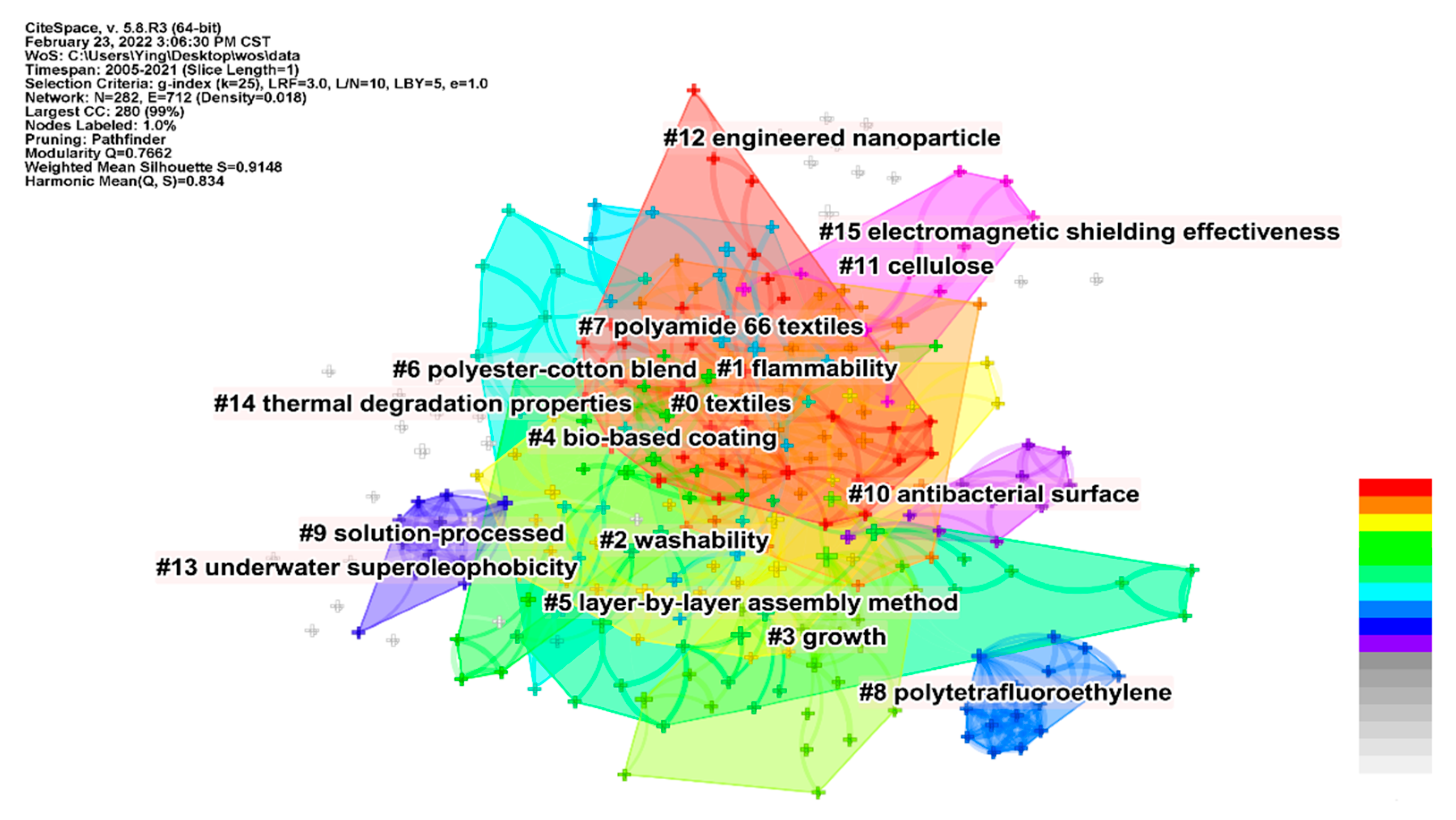
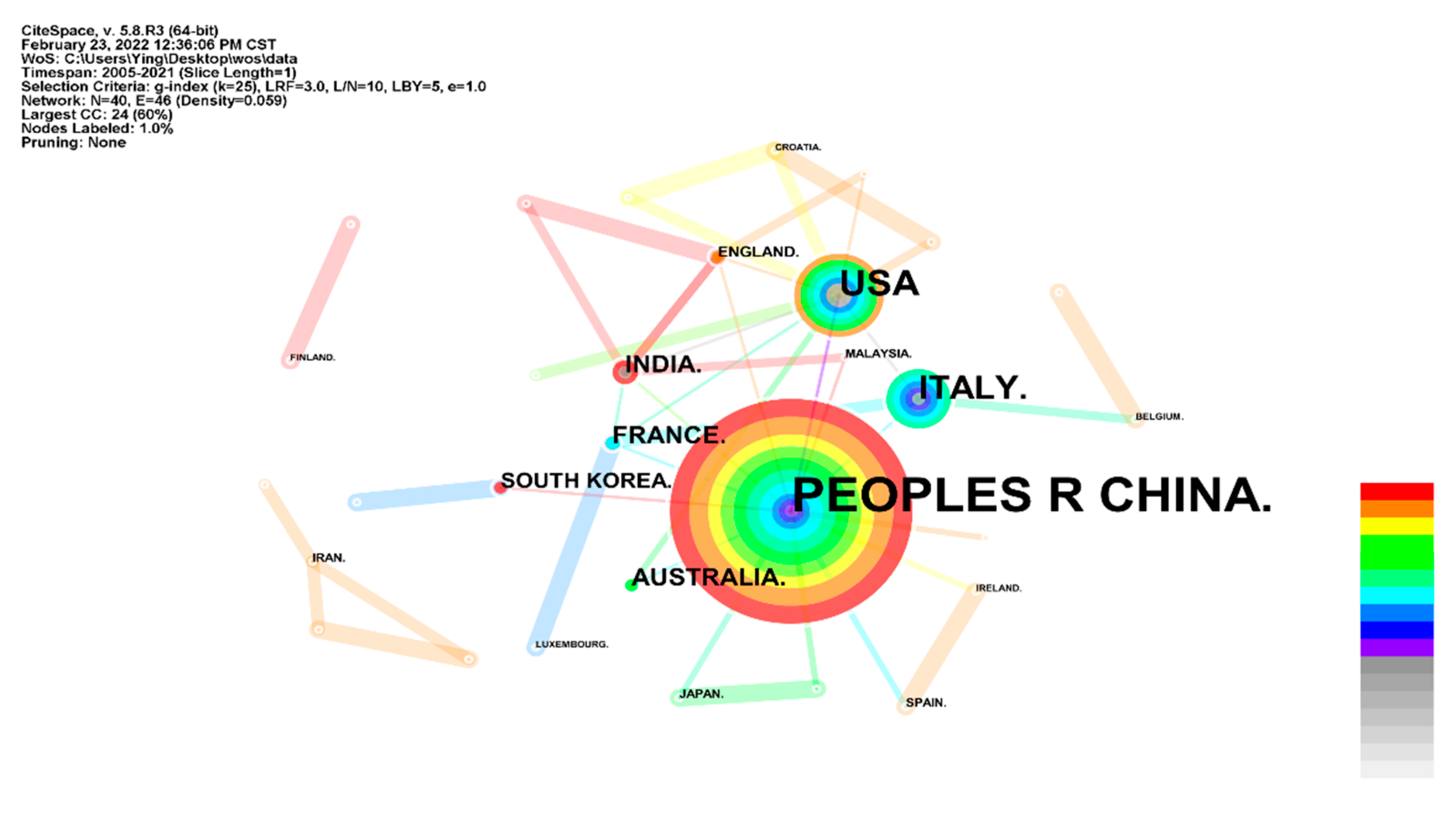
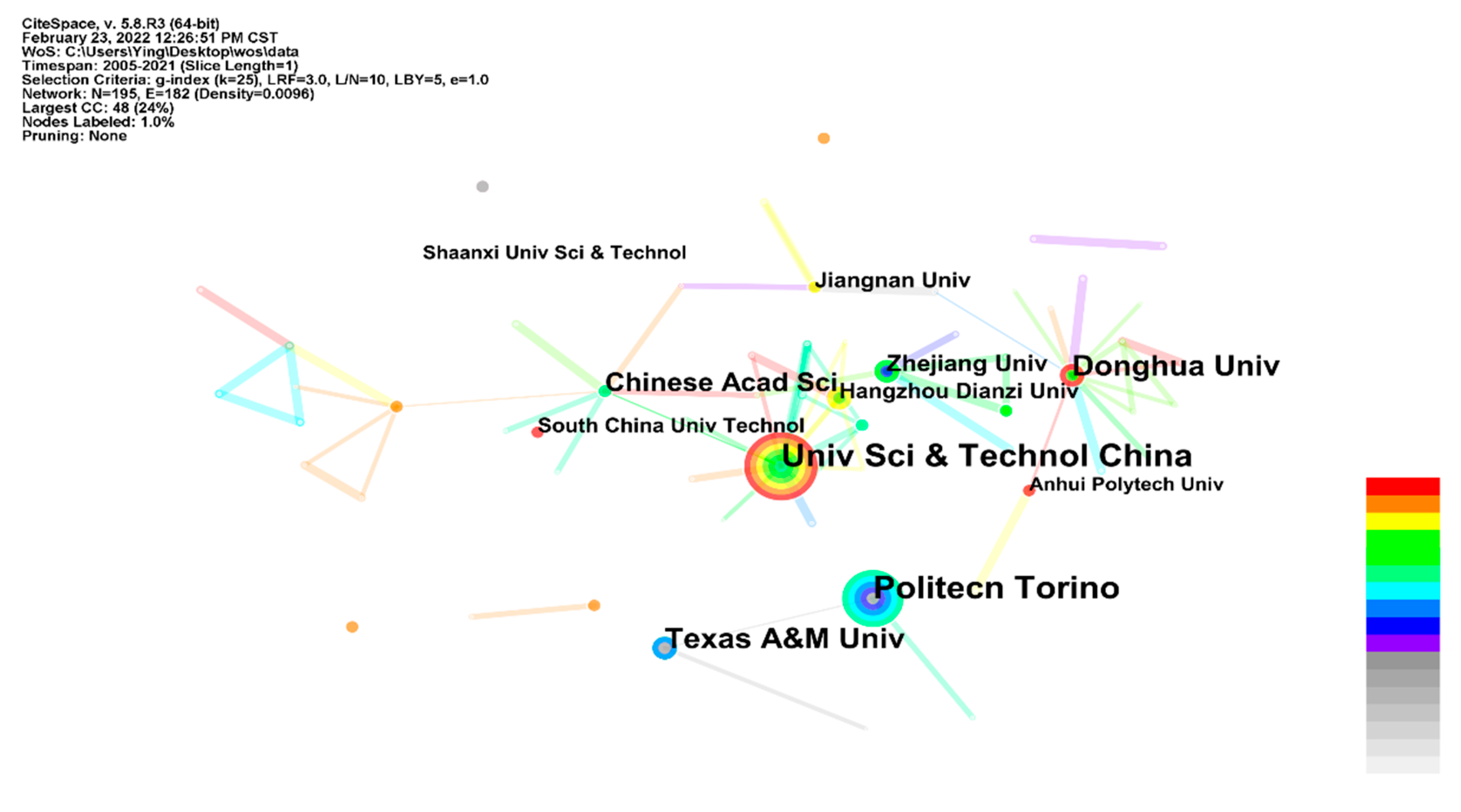
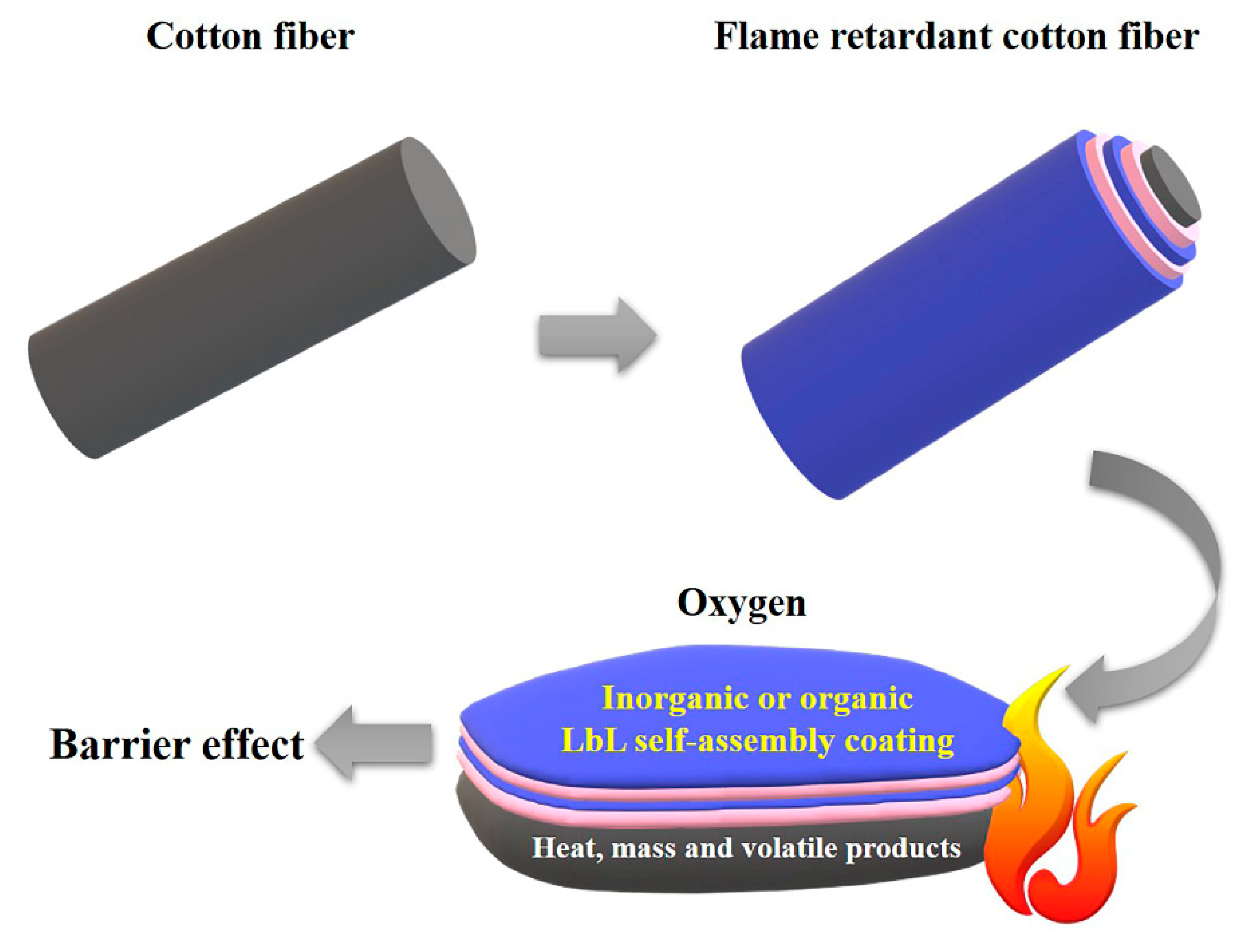
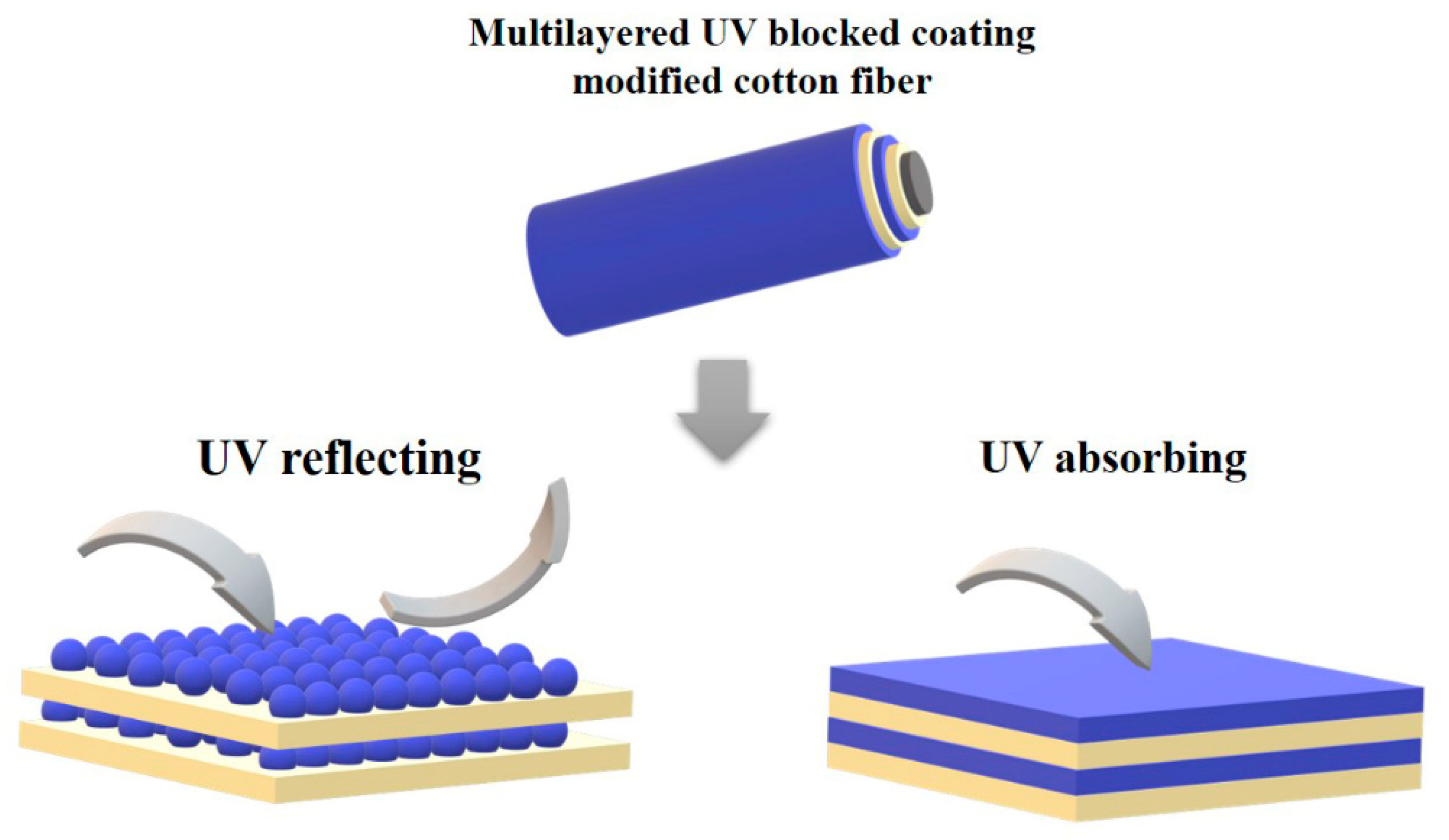

| Frequency | Centrality | Year | Keyword |
|---|---|---|---|
| 50 | 0.09 | 2009 | coating |
| 48 | 0.11 | 2011 | behavior |
| 38 | 0.16 | 2010 | flammability |
| 38 | 0.01 | 2012 | chitosan |
| 38 | 0.07 | 2010 | fiber |
| 38 | 0.15 | 2011 | thin film |
| 32 | 0.19 | 2010 | film |
| 31 | 0.24 | 2011 | cotton fabrics |
| 28 | 0.09 | 2010 | fabrics |
| 27 | 0.02 | 2010 | nanoparticle |
| Frequency | Centrality | First Occurrence | Country |
|---|---|---|---|
| 146 | 0.39 | 2010 | PEOPLES R CHINA. |
| 46 | 0.46 | 2009 | USA |
| 26 | 0.11 | 2011 | ITALY. |
| 12 | 0.29 | 2011 | INDIA. |
| 11 | 0 | 2010 | AUSTRALIA. |
| 10 | 0.21 | 2014 | FRANCE. |
| 7 | 0.06 | 2011 | SOUTH KOREA. |
| 5 | 0 | 2010 | TURKEY. |
| 4 | 0 | 2012 | THAILAND. |
| 4 | 0.36 | 2020 | ENGLAND. |
| Frequency | Centrality | First Occurrence | Institution |
|---|---|---|---|
| 27 | 0.05 | 2014 | Univ. Sci & Technol. China |
| 25 | 0.01 | 2011 | Politecn. Torino |
| 19 | 0.01 | 2009 | Texas A&M Univ. |
| 19 | 0.05 | 2012 | Donghua Univ. |
| 14 | 0.09 | 2015 | Chinese Acad. Sci. |
| 10 | 0.02 | 2013 | Zhejiang Univ. |
| 8 | 0.01 | 2018 | Hangzhou Dianzi Univ. |
| 8 | 0.05 | 2010 | Jiangnan Univ. |
| 7 | 0 | 2016 | South China Univ. Technol. |
| 6 | 0 | 2019 | Anhui Polytech Univ. |
| Fabric | Year | Composition | Layers | Best Burning Test Result | Reference | |
|---|---|---|---|---|---|---|
| Horizontal Burning Test | Vertical Burning Test | |||||
| Cotton | 2009 | BPEI/Laponite | 10 BL | - | More char residue | [71] |
| Polyester | 2011 | α-ZrP/PDAC α-ZrP/POSS α-ZrP/SiO2 | 10 BL | - | - | [72] |
| Cotton | 2011 | PSP/PAAm | 20 BL | - | Self- extinguish | [73] |
| Ramie | 2013 | PEI/APP | 20 BL | - | Self- extinguish | [74] |
| Polyamide 6.6 | 2014 | PAH/PSP | 40 BL | - | - | [75] |
| Polyester-cotton blends | 2017 | PCS/BPEI | 20 BL | Self- extinguish | - | [76] |
| Polyethylene terephthalate | 2019 | PEI/OSA/HA | 15 BL | Self- extinguish | - | [77] |
| Cotton | 2021 | MXene/CCS | 4 BL | Self- extinguish | - | [78] |
| Fabric | Year | Composition | Layers | Bacterial | Reference |
|---|---|---|---|---|---|
| Cotton | 2013 | CH/ALG | CH/ALG/CH/ALG/CH | S. aureus and K. pneumanie | [80] |
| Woven cotton | 2017 | TPP/CHT and PSS/CHT | 15 BL | S. aureus and K. pneumanie | [81] |
| Cotton | 2019 | PCQS/PA | 30 BL | E. coli O157:H7 and S. aureus | [82] |
| Cotton | 2020 | PSS/CS-Ag | 15 BL | S. aureus and E. coli | [83] |
| Linen | 2020 | CH/GTE | 10 BL | S. aureus | [84] |
| PET nonwoven | 2021 | CSN/TPP | 10.5 | S. aureus and E. coli | [85] |
| Fabric | Year | Composition | Layers | UPF | Reference |
|---|---|---|---|---|---|
| Cotton | 2010 | FBAs/PDDA | 10 BL | >70 | [92] |
| Cotton | 2010 | ZnO/ZnO | 16 BL | 12.3 | [93] |
| Cotton | 2013 | PAA/modified LDH | 5 BL | 15.5 | [94] |
| Cotton | 2016 | GO/CH | 10 BL | 452 | [96] |
| Cotton | 2019 | PEI-H/SiO2/HDTMS | 5 BL | 876.13 | [16] |
| Cotton | 2020 | CH/SLS-BA | 3 BL | 77.52 | [95] |
| Fabric | Year | Composition of LbL Self-Assembled Coating | Hydrophobic Layer | Layers | WCA | Reference |
|---|---|---|---|---|---|---|
| Cotton | 2012 | Poly-DMDAAC/SiO2 | (heptadecafluoro-1,1,2,2-tetradecyl) trimethoxysilane | 2 BL | 155° | [20] |
| PET | 2017 | PDDA/CNT | PDMS | 10 BL | 166.9° | [103] |
| Cotton | 2019 | PEI-H/SiO2 | HDTMS | 3 BL | 154° | [16] |
| PET | 2020 | BPEI/PA/APP | PDMS-grafted-TiO2@PDMS | 2 BL | 162° | [55] |
| Cotton | 2021 | CH/CNT | PDMS | 10 BL | 165° | [10] |
| Fabric | Year | Composition | Layers | EMI SE | Electrical Conductivity | Reference |
|---|---|---|---|---|---|---|
| Cotton | 2017 | CH+graphene/PSS | 10 BL | 30.04 dB | 1670 S/m | [109] |
| Cellulose | 2018 | CNT/PAH | 30 BL | 11.9 dB | - | [108] |
| Cotton | 2019 | PEI/PA/AgNWs | 8 BL PEI/PA + 4 layers AgNWs | 32.98 dB | 2416.46 S/m | [110] |
| Cotton | 2021 | GO/PPy | 5 BL | 19.2 dB | - | [111] |
| Cotton | 2021 | GO/PPy | 4 BL | 39.1 dB | - | [112] |
| Carbon fiber | 2021 | PANI/MXene/PDMS | 50 BL | 35.3 dB | 325 S/m | [106] |
Publisher’s Note: MDPI stays neutral with regard to jurisdictional claims in published maps and institutional affiliations. |
© 2022 by the authors. Licensee MDPI, Basel, Switzerland. This article is an open access article distributed under the terms and conditions of the Creative Commons Attribution (CC BY) license (https://creativecommons.org/licenses/by/4.0/).
Share and Cite
Pan, Y.; Fu, L.; Du, J.; Zhang, D.; Lü, T.; Zhang, Y.; Zhao, H. Layer-by-Layer Self-Assembly Coating for Multi-Functionalized Fabrics: A Scientometric Analysis in CiteSpace (2005–2021). Molecules 2022, 27, 6767. https://doi.org/10.3390/molecules27196767
Pan Y, Fu L, Du J, Zhang D, Lü T, Zhang Y, Zhao H. Layer-by-Layer Self-Assembly Coating for Multi-Functionalized Fabrics: A Scientometric Analysis in CiteSpace (2005–2021). Molecules. 2022; 27(19):6767. https://doi.org/10.3390/molecules27196767
Chicago/Turabian StylePan, Ying, Li Fu, Jia Du, Dong Zhang, Ting Lü, Yan Zhang, and Hongting Zhao. 2022. "Layer-by-Layer Self-Assembly Coating for Multi-Functionalized Fabrics: A Scientometric Analysis in CiteSpace (2005–2021)" Molecules 27, no. 19: 6767. https://doi.org/10.3390/molecules27196767
APA StylePan, Y., Fu, L., Du, J., Zhang, D., Lü, T., Zhang, Y., & Zhao, H. (2022). Layer-by-Layer Self-Assembly Coating for Multi-Functionalized Fabrics: A Scientometric Analysis in CiteSpace (2005–2021). Molecules, 27(19), 6767. https://doi.org/10.3390/molecules27196767







